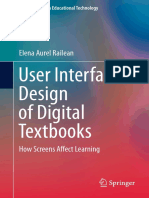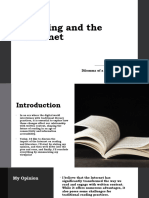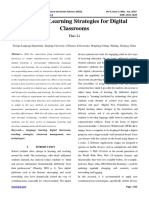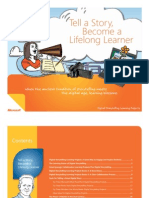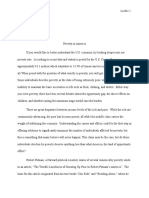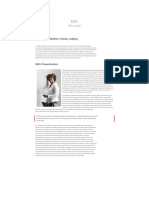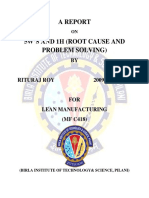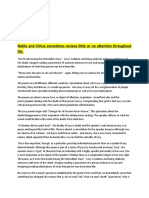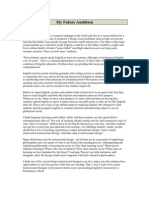COST E-READ Stavanger Declaration Concerning The Future of Reading
COST E-READ Stavanger Declaration Concerning The Future of Reading
Uploaded by
HIPS17Original Description:
Original Title
Copyright
Available Formats
Share this document
Did you find this document useful?
Is this content inappropriate?
Report this DocumentCopyright:
Available Formats
COST E-READ Stavanger Declaration Concerning The Future of Reading
COST E-READ Stavanger Declaration Concerning The Future of Reading
Uploaded by
HIPS17Copyright:
Available Formats
COST E-READ Stavanger Declaration
Concerning the Future of Reading
We live in an era of ever more swift and pervasive digitisation. Digital technologies offer tremendous
opportunities with respect to the production, access, storage and transmission of information, at the
same time as they challenge a number of long-established reading practices. Over the last four years a
group of almost 200 scholars and scientists of reading, publishing, and literacy from across Europe,
have been researching the impact of digitisation on reading practices.
Paper and screens each afford their own types of processing. In today's hybrid reading environment of
paper and screens, we will need to find the best ways to utilize the advantages of both paper and digital
technologies across age groups and purposes.
Research shows that paper remains the preferred reading medium for longer single texts, especially
when reading for deeper comprehension and retention, and that paper best supports long-form reading
of informational texts. Reading long-form texts is invaluable for a number of cognitive achievements,
such as concentration, vocabulary building and memory. Thus, it is important that we preserve and
foster long-form reading as one of a number of reading modes. In addition, as screen use continues to
grow, it will be one of the urgent challenges to discover ways in which to facilitate deep reading of
long-form texts in a screen environment.
Key findings:
• Individual differences in skills, abilities, and predispositions form distinct
learning profiles that affect children’s ability to use and learn from digital versus print
sources;
• Digital text offers excellent opportunities to tailor text presentation to an
individual's preferences and needs. Benefits for comprehension and motivation have
been demonstrated where the digital reading environment was carefully designed with
the reader in mind;
• Digital environments also pose challenges. Readers are more likely to be
overconfident about their comprehension abilities when reading digitally than when
reading print, in particular when under time pressure, leading to more skimming and
less concentration on reading matter;
• A meta-study of 54 studies with more than 170.000 participants demonstrates
that comprehension of long-form informational text is stronger when reading on paper
than on screens, particularly when the reader is under time pressure. No differences
were observed on narrative texts;
• Contrary to expectations about the behaviour of ‘digital natives’, such screen
inferiority effects compared to paper have increased rather than decreased over time,
regardless of age group and of prior experience with digital environments;
• Our embodied cognition (i.e. that how and what we learn, know, and can do
depends on features of the entire physical body) may contribute to differences between
reading on paper and on screen in terms of comprehension and retention. This factor is
underestimated by readers, educators and even researchers.
These findings are consistent with those conducted in countries outside of Europe. In light of these
findings, we have formulated the following recommendations:
Recommendations:
• Systematic and careful empirical investigation into the conditions under which
learning and comprehension is enhanced – and of the circumstances under which they
are hindered – in both print and digital environments needs to be conducted.
• Students should be taught strategies they can use to master deep reading and
higher-level reading processes on digital devices. In addition, it remains important that
schools and school libraries continue to motivate students to read paper books, and to set
time apart for it in the curriculum.
• Teachers and other educators must be made aware that rapid and indiscriminate
swaps of print, paper, and pencils for digital technologies in primary education are not
neutral. Unless accompanied by carefully developed digital learning tools and strategies,
they may cause a setback in the development of children’s reading comprehension and
emerging critical thinking skills;
• Appropriate action is needed to develop better guidelines for the implementation
of digital technologies, especially in education, but also in media environments more
generally. With respect to education this pertains, for example, to the development of
empirically validated instruction in digital literacy skills (selecting, navigating,
evaluating, and integrating information encountered digitally). Such digital skills will be
applicable in many contexts, for example in dealing with government communication
and other public information;
• Educators, reading experts, psychologists, and technologists should partner to
develop digital tools (and related software) that incorporate insights from research about
the processing of digital and printed formats, including the role of embodied cognition,
for reading practices;
• Further research into digital learning materials should involve increased
cooperation among technology developers and humanities and social science researchers
to help facilitate unbiased and evidence-based public debates on the digital
transformation.
Questions for future research
As the use of digital materials for both education and personal reading grows, important questions
about the future of reading, the pedagogy of literacy, and the long-standing importance of textual
communication arise:
• In what reading contexts and for what readers can the use of digital text be most
fruitful?
• Conversely, in which domains of learning and literary writing should the medium of
paper be encouraged and championed?
• Is the tendency for screen reading to be more fragmented, less concentrated, and to
involve more shallow processing turning skimming into the default reading mode that is
carried over to paper reading habits?
• Is our susceptibility to fake news, biases and prejudices amplified by overconfidence
in our digital reading skills?
• What can be done to encourage deeper processing of texts in general and, in
particular, of texts read on screen?
Who are we?
Evolution of Reading in the Age of Digitisation (E-READ) is a European research initiative bringing
together almost 200 scholars and scientists of reading, publishing, and literacy from across Europe, in
a joint effort to research the impact of digitisation on reading practices. Much of our research has
focused on how readers, and particularly children and young adults, comprehend or remember written
text when using print versus digital materials. The members and relevant stakeholders of this EU-
funded COST research Action met on 3–4 October 2018, in Stavanger, Norway, to discuss the main
findings of four years of empirical research and debates (2014 – 2018). The Stavanger Declaration
Concerning the Future of Reading represents a summary of this exchange.
You might also like
- Digital LiteracyDocument54 pagesDigital LiteracyRhea EboraNo ratings yet
- The Human Flourishing PPT ?Document20 pagesThe Human Flourishing PPT ?Jennypee Madrina88% (8)
- User Interface Design of Digital Textbooks: Elena Aurel RaileanDocument108 pagesUser Interface Design of Digital Textbooks: Elena Aurel RaileanCarolina Medina DeLargeNo ratings yet
- 182911-Article Text-465782-1-10-20190201Document12 pages182911-Article Text-465782-1-10-20190201speedotNo ratings yet
- Manifiesto Sobre La Importancia de La LecturaDocument26 pagesManifiesto Sobre La Importancia de La LecturarodrigopardofNo ratings yet
- Why Higher-Level Reading Is ImportantDocument25 pagesWhy Higher-Level Reading Is ImportantAnanthan PsNo ratings yet
- Presentation Group1Document23 pagesPresentation Group1api-241637663No ratings yet
- Lorelei FlojoDocument54 pagesLorelei FlojoIgna Ana S. ValeraNo ratings yet
- Презентация 8Document10 pagesПрезентация 8Тимур РаспоповNo ratings yet
- Icts in Education: B.Ed Iii Prof. Dr. Bushra Iqbal ChohanDocument54 pagesIcts in Education: B.Ed Iii Prof. Dr. Bushra Iqbal Chohanbushra chohanNo ratings yet
- Background of The StudyDocument31 pagesBackground of The StudyAlits BañaderaNo ratings yet
- L1 BenlacDocument38 pagesL1 BenlacCABRERA ABIGAIL P.No ratings yet
- Digital LiteracyDocument12 pagesDigital LiteracyMadonna DvalashviliNo ratings yet
- Handout 1.1 What Is LiteracyDocument1 pageHandout 1.1 What Is LiteracyShagufta MoghalNo ratings yet
- Educ 2106 M1L3Document3 pagesEduc 2106 M1L3Chlaire GongoraNo ratings yet
- Business CommunicationDocument16 pagesBusiness Communicationqqcg7wgnf9No ratings yet
- Literature Review On E-Learning in NigeriaDocument11 pagesLiterature Review On E-Learning in Nigeriagvzph2vh100% (1)
- Notes/ Synthesis For Module 1 - Building and Enhancing New Literacies Across The CurriculumDocument4 pagesNotes/ Synthesis For Module 1 - Building and Enhancing New Literacies Across The CurriculumMannuelle GacudNo ratings yet
- Reading Styles of 21st Century Learners in Modular Distance Learning ModalityDocument10 pagesReading Styles of 21st Century Learners in Modular Distance Learning ModalityEditor IJTSRDNo ratings yet
- Language Learning Strategies For Digital ClassroomsDocument6 pagesLanguage Learning Strategies For Digital ClassroomsIJELS Research JournalNo ratings yet
- Applied Technology: Innovation in College Library Services: Dr. Prashant P BopapurkarDocument3 pagesApplied Technology: Innovation in College Library Services: Dr. Prashant P BopapurkarProfessor.Krishan Bir SinghNo ratings yet
- Digital Divide and Digital Library Environment: Bridging The Gap Through Information Literacy and Role of Academic CommunityDocument19 pagesDigital Divide and Digital Library Environment: Bridging The Gap Through Information Literacy and Role of Academic CommunityDavid StaffordNo ratings yet
- Learn TheoDocument10 pagesLearn TheochaukeenNo ratings yet
- Digital Literacy Presentation 1 For SchoolDocument28 pagesDigital Literacy Presentation 1 For Schoolnasir100% (1)
- Web, Information, New, Digital LiteracyDocument19 pagesWeb, Information, New, Digital LiteracyRoselet ApiñadoNo ratings yet
- Digital Storytelling e BookDocument28 pagesDigital Storytelling e BookAna Isabel Almeida100% (1)
- Power Point On LiteraciesDocument32 pagesPower Point On Literaciesxxzipper1No ratings yet
- Group 3 ReportDocument36 pagesGroup 3 ReportNergie ResurrecionNo ratings yet
- A Survey of Readers Reading Preference Digital or Printed TextDocument9 pagesA Survey of Readers Reading Preference Digital or Printed TextKharlotta RamosNo ratings yet
- It's Time To Turn The Digital Page: Preservice Teachers Explore Ebook ReadingDocument12 pagesIt's Time To Turn The Digital Page: Preservice Teachers Explore Ebook Readingapi-288781822No ratings yet
- Ict For Teacher Professional Development MDocument14 pagesIct For Teacher Professional Development Mapi-231516879No ratings yet
- Kristine Bernadette ADocument4 pagesKristine Bernadette AKristine Bernadette NuestroNo ratings yet
- Integration of New Literacies in The CurriculumDocument10 pagesIntegration of New Literacies in The CurriculumMariel Mae PolancosNo ratings yet
- Description What We Know About Adolescent ReadingDocument8 pagesDescription What We Know About Adolescent ReadingSuasana ResmiNo ratings yet
- Technology and Language TeachingDocument20 pagesTechnology and Language TeachingennadirhafsaNo ratings yet
- Business Communication-Ruturaj AsaneDocument16 pagesBusiness Communication-Ruturaj Asaneqqcg7wgnf9No ratings yet
- Textbook Ni KirtsDocument1 pageTextbook Ni KirtsAnime FreeNo ratings yet
- Integrating Tech & BloggingDocument19 pagesIntegrating Tech & BloggingVinique HerholdtNo ratings yet
- Changing Classroom Practice Through Blogs and VlogsDocument12 pagesChanging Classroom Practice Through Blogs and VlogsMary Grace JimenezNo ratings yet
- Developing Digital Language Learning MaterialsDocument44 pagesDeveloping Digital Language Learning MaterialsHazel Ruales100% (1)
- Literature Review ElectronicDocument7 pagesLiterature Review Electronicafmzrxbdfadmdq100% (1)
- Internet For EducationDocument3 pagesInternet For EducationZismi AyusfinaNo ratings yet
- Background of The StudyDocument3 pagesBackground of The StudyMarNo ratings yet
- Lesson 1Document22 pagesLesson 1Moya BotesNo ratings yet
- Information LiteracyDocument21 pagesInformation LiteracyJov SoyomNo ratings yet
- Lit Review Amcdonald Edld 5315Document9 pagesLit Review Amcdonald Edld 5315api-727472231No ratings yet
- Information Literacy What Is Information Literacy? Thompson & HenleyDocument3 pagesInformation Literacy What Is Information Literacy? Thompson & HenleyMarco JavierNo ratings yet
- LR Campus Post NewsletterDocument2 pagesLR Campus Post Newsletterapi-337515160No ratings yet
- Print Vs Digital Reading Comprehension in EflDocument15 pagesPrint Vs Digital Reading Comprehension in EflErick OpiyoNo ratings yet
- The Modern Learner Requires A Different Method and A Different View On ContentDocument3 pagesThe Modern Learner Requires A Different Method and A Different View On Contentthnddube4358No ratings yet
- Rethinking Pedagogy in A Digital AgeDocument2 pagesRethinking Pedagogy in A Digital AgeLeonardo LangaroNo ratings yet
- Borderless Education With NotesDocument24 pagesBorderless Education With Notesmonica.jagolinoNo ratings yet
- What Is Digital Literacy? A Comparative Review of Publications Across Three Language ContextsDocument18 pagesWhat Is Digital Literacy? A Comparative Review of Publications Across Three Language ContextsEdo RahmanNo ratings yet
- What Are Icts and What Types of Icts Are Commonly Used in Education?Document2 pagesWhat Are Icts and What Types of Icts Are Commonly Used in Education?Jayvee Amoy AmolatoNo ratings yet
- Rahul Marketing Project PDFDocument13 pagesRahul Marketing Project PDFshubham roteNo ratings yet
- Role of ICT in EducationDocument4 pagesRole of ICT in EducationAbdulRehman100% (1)
- Characteristics of A 21st-Century TeacherDocument24 pagesCharacteristics of A 21st-Century Teacherdany mosbyNo ratings yet
- Literature Review On Communication TechnologyDocument7 pagesLiterature Review On Communication Technologyetmqwvqif100% (1)
- Teaching for Understanding with TechnologyFrom EverandTeaching for Understanding with TechnologyRating: 4 out of 5 stars4/5 (1)
- Hampton 1987 Free-Rider Problems in The Production of Collective GoodsDocument30 pagesHampton 1987 Free-Rider Problems in The Production of Collective GoodsBrad TaylorNo ratings yet
- "Use of Body Language": PPT Project OnDocument7 pages"Use of Body Language": PPT Project OnJatin AhujaNo ratings yet
- LiteratureToM Resub CopyeditedDocument68 pagesLiteratureToM Resub CopyeditedLê Nguyễn Khánh MinhNo ratings yet
- Executive Director Position DescriptionDocument2 pagesExecutive Director Position Descriptionapi-251322739No ratings yet
- English Essay: " Lolita or The Confession of A White Widowed Male"Document5 pagesEnglish Essay: " Lolita or The Confession of A White Widowed Male"Linda HayashiNo ratings yet
- 3P PDFDocument35 pages3P PDFpranayrulz100% (1)
- Art Installation Workshop: Concepting Out of The Box & Meaningful Art InstallationDocument33 pagesArt Installation Workshop: Concepting Out of The Box & Meaningful Art InstallationMuhammad Farhan PristantyoNo ratings yet
- Poverty in America Causal - Rough DraftDocument4 pagesPoverty in America Causal - Rough Draftapi-357642398No ratings yet
- Behaviorism (Also Called Learning Perspective) Is A Philosophy ofDocument20 pagesBehaviorism (Also Called Learning Perspective) Is A Philosophy ofARNOLDNo ratings yet
- SMAI Assignment 7 Report - 20161204 PDFDocument6 pagesSMAI Assignment 7 Report - 20161204 PDFAliNo ratings yet
- John John ActivityDocument3 pagesJohn John ActivityMicah ToqueroNo ratings yet
- Epp DatDocument13 pagesEpp DatJoy Lorain PasudagNo ratings yet
- Parenting Style and The Development of ReasioningDocument17 pagesParenting Style and The Development of ReasioningSita Maria CalistaNo ratings yet
- ĐỀ GIỮA KỲ I. ANH 7Document4 pagesĐỀ GIỮA KỲ I. ANH 7banthandoraemonNo ratings yet
- Factors Affecting The Choice of College Courses: Their Impacts To Students' Present StudiesDocument4 pagesFactors Affecting The Choice of College Courses: Their Impacts To Students' Present StudiesmarvinNo ratings yet
- Art Performance Task and RubricDocument3 pagesArt Performance Task and Rubricapi-401010000No ratings yet
- Brain Training Secrets of Olymic AthletesDocument6 pagesBrain Training Secrets of Olymic AthletesDenis SaricNo ratings yet
- First Time Manager - Mccormick Et Al - EbsDocument12 pagesFirst Time Manager - Mccormick Et Al - EbsSatria IndraprastaNo ratings yet
- ENFJ Personality Type - ENFJ Profile - Personality at WorkDocument4 pagesENFJ Personality Type - ENFJ Profile - Personality at WorkFahm AliyiNo ratings yet
- A Report On 5w S and 1h Root Cause and PDocument23 pagesA Report On 5w S and 1h Root Cause and PalexrferreiraNo ratings yet
- Poetry Assignment Lucy PoemsDocument3 pagesPoetry Assignment Lucy PoemsShani ManiNo ratings yet
- Terminal ReportDocument9 pagesTerminal ReportKaye MamisaoNo ratings yet
- Future AmbitionDocument2 pagesFuture AmbitionbeckiekangNo ratings yet
- Fall21 BCOM Study Guide For Test 1Document2 pagesFall21 BCOM Study Guide For Test 1Saanvi DusaNo ratings yet
- MODULE 1: The Self From Various Perspectives: Part I: PhilosophyDocument6 pagesMODULE 1: The Self From Various Perspectives: Part I: PhilosophyShin AvilaNo ratings yet
- English For Academic and Professional PurposesDocument18 pagesEnglish For Academic and Professional Purposes11 STEM 6 - John Francis QuijanoNo ratings yet
- MATURITYDocument14 pagesMATURITYella perezNo ratings yet
- Statement of UnderatandingDocument1 pageStatement of Underatandingapi-249826975No ratings yet
- Example ScaffoldDocument6 pagesExample Scaffoldapi-105411832No ratings yet


